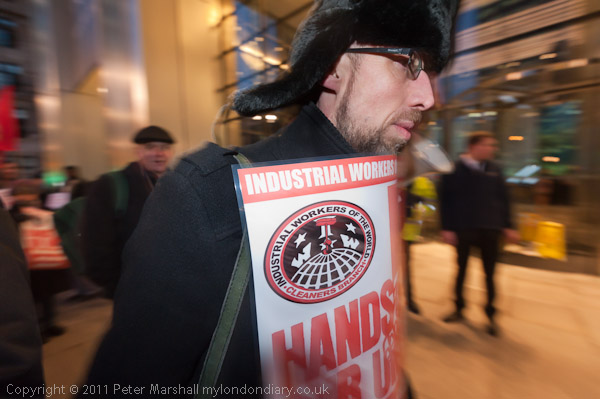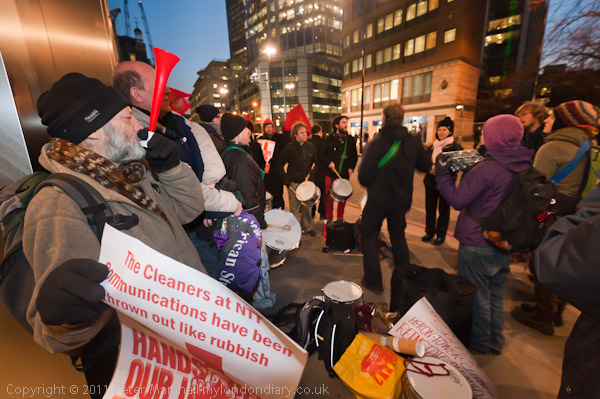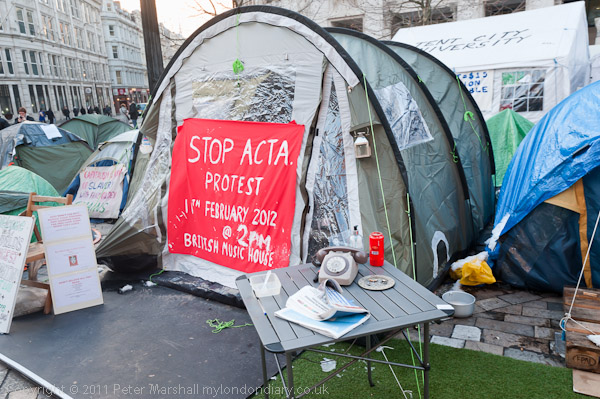IWW Demand ‘Reinstate Alberto’, Occupy & London: On Friday 10th February 2012 I came to London to photograph a rush hour protest calling for the reinstatement of an office cleaner sacked for his union activities. I came early to wander a little from Waterloo and pay a visit to Occupy London on the way there, and also took a few pictures on my way home after the protest.
IWW Cleaners Demand ‘Reinstate Alberto’ – Heron Tower, Bishopsgate

Cleaners were protesting outside the 230 metre tall Heron Tower (now Salesforce Tower) at 110 Bishopsgate, completed in 2007 when it then was the tallest building in the City of London.

The protest called for the reinstatement of IWW Branch Secretary Alberto Durango who had been sacked, victimised for his trade union activities, after the cleaning contract for the building had been taken over by a new contractor, Incentive FM Group Ltd.

Alberto who worked as a cleaner in the Heron Tower had become well known for his campaigning activities in and around the City of London, which have helped to secure better working conditions and the London Living Wage for many of the cleaners who work in London’s prestigious offices. He was then the Industrial Workers of the World Cleaners and Allied Trades Branch Secretary and in 2011 had won the fight for workers at Heron Tower to be paid the London Living Wage and an agreement with the then employer that there would be no redundancies there with any staff reductions needed being made by transfers to alternative posts.

Under the Transfer of Undertakings (Protection of Employment) Regulations (TUPE) the new employer should have continued to recognise this agreement. Instead they refused to do so and picked on Alberto, making him redundant.

The same management also controlled Exchange Tower where the IWW were carrying out a campaign to get cleaners the London Living Wage and where they have taken a very aggressive stance against the union, threatening the union members. The protesters connected Alberto’s sacking with his role there as union Branch Secretary.

This was a very loud protest with speakers using a powerful megaphone and drummers from Rhythms of Resistance adding their loud beats as office workers from Heron Tower and the many other offices in the area were making their way home in the evening rush hour.

The pavement outside the area owned by Heron Tower on Bishopsgate is relatively narrow and police rightly insisted that there needed to be a clear route along it for workers to get past without having to step into the busy road. So my 15mm fisheye lens was extremely useful, though it does make the area look much more spacious than it was.

In February the protest began a quarter of an hour after sunset, and light was fading fast. Although the City streets are generally well light both from street lighting and by the light from the huge areas of glass on the front of modern buildings I used added lighting for many of the pictures, either with a hand held LED light or flash on camera. But neither light source can cover the 180 degree diagonal view of the fisheye and those pictures rely on available light only. Its f2.8 maximum aperture helped – and it was a stop faster than the wide-angle zoom used for almost all the other images. In some at least of the pictures I think the fish-eye effect works well too.
More at IWW Cleaners Demand Reinstate Alberto.
Occupy London & Other Pictures – St Paul’s Cathedral

Although there were still plenty of tents in St Paul’s Churchyard as I walked through they were all tightly closed and the occupiers were still out protesting the music anti-piracy proposals at the British Music House in Soho.

I was a disappointed at not meeting any of them, although I hadn’t arranged to do so and it did allow me to take a few pictures of the site without any distractions, though by the time I’d wandered there taking a few pictures on the way including from the Millenium footbridge I was in a hurry to get to the Heron Tower.

After the protest at the Heron Tower I took a bus back to Westminster and made a few pictures in the subway leading from the station to the Houses of Parliament and under the Emabankment towards the Thames before walking across the bridge and to Waterloo Station.

More pictures Occupy London Still At St Pauls.
Flickr – Facebook – My London Diary – Hull Photos – Lea Valley – Paris
London’s Industrial Heritage – London Photos
All photographs on this page are copyright © Peter Marshall.
Contact me to buy prints or licence to reproduce.











